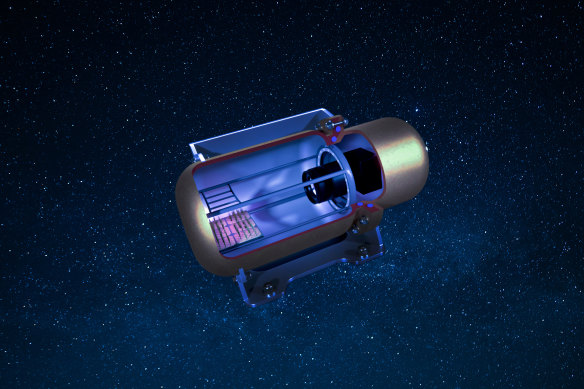From a lab to the moon: Growing plants in outer space
By Laura Chung
Growing plants on the moon sounds like something out of a sci-fi movie, but it is about to become a reality for a start-up project.
Seeds will be transported more than 300,000 kilometres into space in a specially designed chamber – equipped with sensors, water and a camera – aboard a lunar lander scheduled for a mission in 2026.

A rendition of the chamber that could be sent to space, containing precious plants.Credit: Arthur Georgalas, RMIT University, (graphic created by Stephen Kiprillis)
The project – led by start-up Lunaria One with RMIT, QUT and ANU as the major Australian university partners – has received $3.6 million from the federal government.
After landing on the moon, the plants’ health will be monitored and used to understand how to better grow plants in extreme environments, including whether growing them in space is a viable solution for future food security concerns.
Climate change is set to reduce water availability across the world, while land and sea temperatures increase. In Australia, food-producing regions are already getting drier. For example, research by the Australian Conservation Foundation shows that over the past 20 years, average in-flows of water into the Murray River have been reduced by about 40 per cent.
But the scientists face several challenges before their chamber blasts off. The first is designing a chamber that can withstand the space journey temperature fluctuations from highs of 80 degrees to lows of minus 180 degrees.
Lunaria One co-founder and the engineering lead for the project, RMIT’s Dr Graham Dorrington, said the chamber would also need to be lightweight – no more than 1.5 kilograms – and able to operate on minimal power while transmitting data back to Earth.
“These are considerable challenges but one that is doable,” he said. “We started with asking schoolchildren what they would like to do on the moon. And their response was to grow plants. Despite the childlike naivety, it has withstood scrutiny from NASA and the Australian Space Agency.
“I believe there is an innate desire in humans to spread life in the solar system. This project has taken a life of its own. But we see it as a sequence of more ambitious projects that could lead to commercial spin-offs.”
RMIT Associate Professor at the School of Science Tien Huynh, a contributor to the project’s plant team, is in charge of finding out which plants are suitable for the journey. Her team has tested more than 20 types of plants, trying to find the best-suited.
One of those options is rapeseed, a yellow-flowering plant that has a range of industrial and food production uses.
“We know some plants grow differently in altered gravity conditions, but don’t yet fully understand how and why,” she said. “In addition, the harsh lunar environment has a thin atmosphere, rapidly changing temperatures, and relatively poor soil properties, meaning that whatever we grow on the surface will need to be hardy.
“Space is the next frontier. The end game is to go to Mars which is very uninhabitable. We could be looking at having plant hubs in space to grow edible food for us. There is much-unexplored territory. Australians are not known for space exploration, but this could be a chance to have our name on there.”
The Morning Edition newsletter is our guide to the day’s most important and interesting stories, analysis and insights. Sign up here.